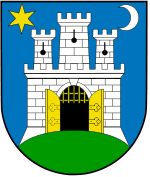Gornji Grad–Medveščak

.svg.png)

Gornji Grad–Medveščak (Croatian pronunciation: [gôːrɲiː grâːd medʋěʃt͡ʃaːk], Croatian: Upper Town–Medveščak) is one of the districts of Zagreb, Croatia; Gornji Grad translates as Upper Town. The district is located in the central part of the city and, according to the 2011 census, it has 30,962 inhabitants[1] spread over 10.12 km2 (3.91 sq mi).
Gornji Grad – Medveščak is a district with a high number of historic sites and tourist attractions. Gradec and Kaptol, the two distinct cores of medieval Zagreb, are forming today's Upper Town, and both are parts of this district. The city's Cathedral, the St. Mark's Church and the Croatian Parliament are located in Gornji Grad, as is the popular pedestrian café street Tkalčićeva. There are also other noteworthy objects located outside of the oldest historical towns, such as city's monumental cemetery Mirogoj that was built since 1876, located further north.
It is bordered by four other districts: Donji Grad in the south, Črnomerec in the west, Maksimir in the east and Podsljeme in the north.
Streets and transport
The most important arterial road in Gornji Grad–Medveščak flows between its southern and northern border, starting as a narrow Ribnjak street alongside the Ribnjak park, then widening and changing name to Medveščak street until Gupčeva zvijezda, and again changing name in the north to Ksaver. The road is the main tram connection for Medveščak (lines 8 and 14). The district is also connected in its southern borders by many other important tram lines that run along Ilica, Jurišićeva and Vlaška streets. The short historic Zagreb funicular connects Lower and Upper town, and several less frequent (every 20-45 minutes) bus routes run through the hilly and less populated northern areas.
Government
Belonging to the districts with a population between 30,000 and 50,000, Gornji Grad – Medveščak is ruled by a council consisting of 15 councilmen appointed at the 2005 elections.[2][3] A majority of six seats is held by the coalition of Social Democratic Party (SDP), Croatian Peasant Party (HSS) and Croatian Party of Pensioners (HSU). The other dominant coalition, Croatian Democratic Union (HDZ), Democratic Centre (DC) and Croatian Social Liberal Party (HSLS), won three seats. The SDP–HSS–HSU coalition has appointed the council president, SDP member Anđelko Šućur. The vice president is Miljenko Radetić, also a member of SDP.[3]
List of neighborhoods in Gornji Grad–Medveščak
- Gornji grad
- Gupčeva zvijezda
- Kaptol
- Kraljevec
- Ksaver
- Medveščak
- Mirogoj
- Nova Ves
- Pantovčak
- Petrova
- Ribnjak
- Šalata
- Tkalčićeva Street
- Tuškanac
- Voćarska
- Zelengaj
See also
References
- ↑ "Population by Age and Sex, by Districts of City of Zagreb, 2011 Census". Census of Population, Households and Dwellings 2011. Zagreb: Croatian Bureau of Statistics. December 2012.
- ↑ "Tijela gradskih četvrti i načini njihova izbora". City of Zagreb (in Croatian). Retrieved 2008-11-22.
- 1 2 "Vijeće gradske četvrti". City of Zagreb (in Croatian). Retrieved 2008-11-22.
External links
| Wikimedia Commons has media related to Gornji Grad-Medveščak. |
Coordinates: 45°49′41.69″N 15°58′45.68″E / 45.8282472°N 15.9793556°E
